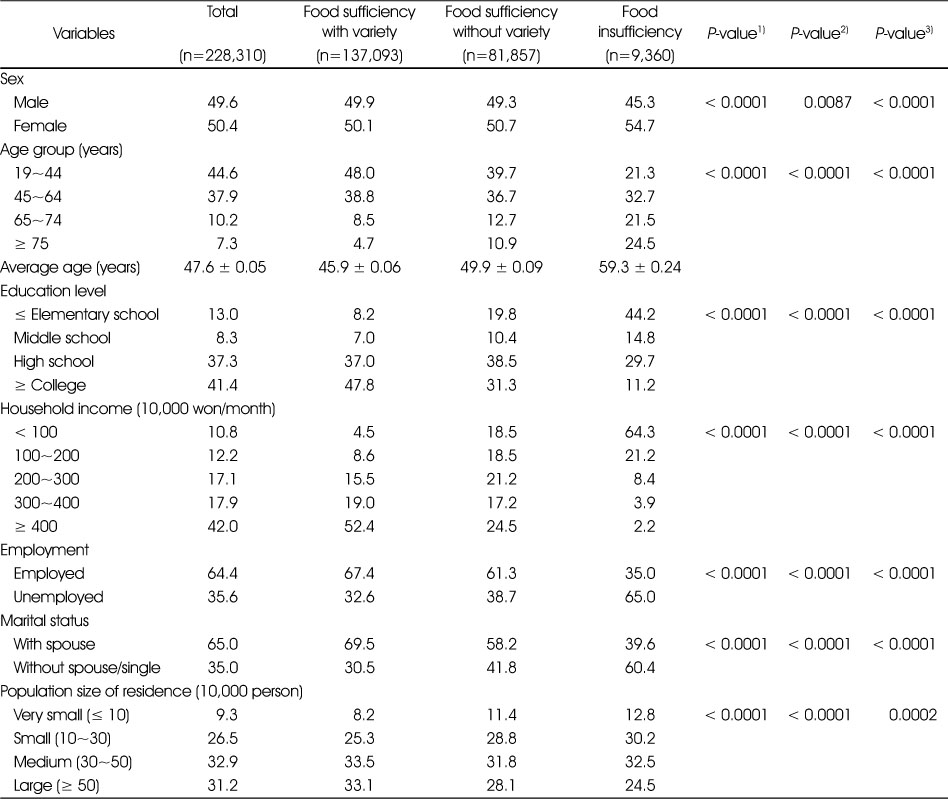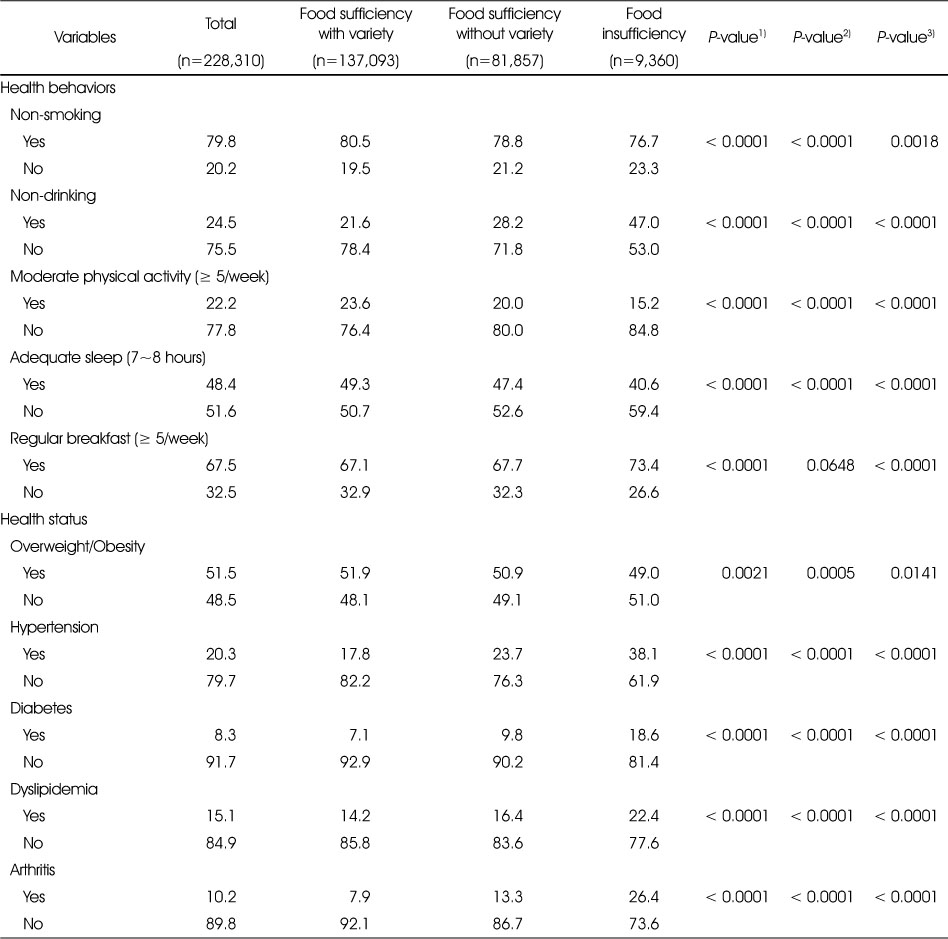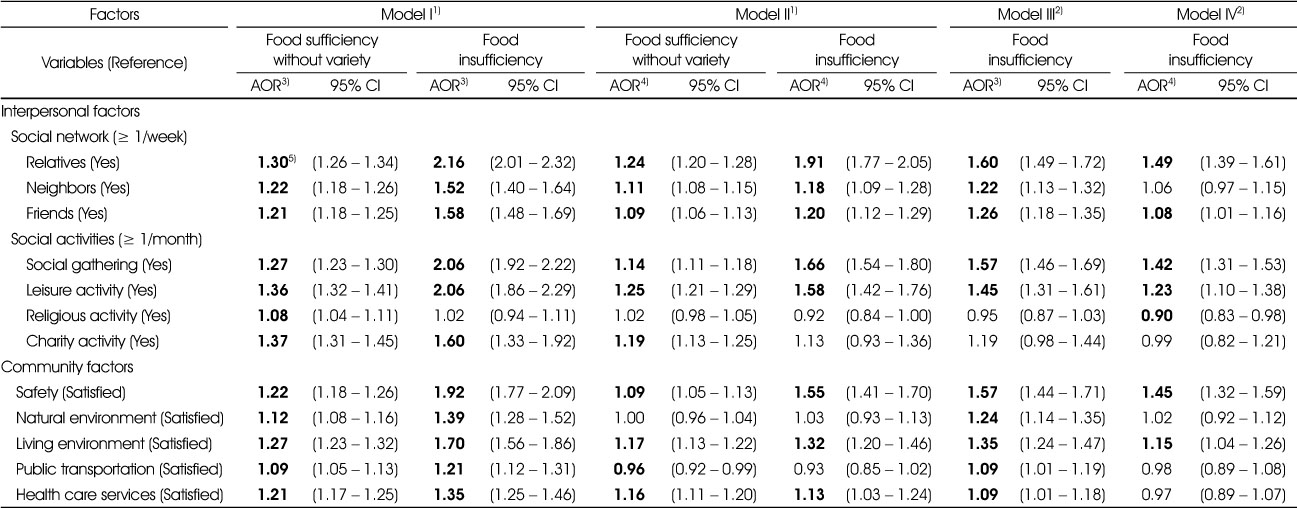Articles
- Page Path
- HOME > Korean J Community Nutr > Volume 25(5); 2020 > Article
- Research Article
- Interpersonal and Community Factors Related to Food Sufficiency and Variety: Analysis of Data from the 2017 Community Health Survey
- Jiyoun Hong, Taisun Hyun
-
Korean Journal of Community Nutrition 2020;25(5):416-429.
DOI: https://doi.org/10.5720/kjcn.2020.25.5.416
Published online: October 31, 2020

2Professor, Department of Food and Nutrition, Chungbuk National University, Cheongju, Korea

-
Corresponding author:
Taisun Hyun,
Email: taisun@cbnu.ac.kr
- 857 Views
- 5 Download
- 3 Crossref
- 0 Scopus
Abstract
Objectives
This study examined the personal, interpersonal and community factors related to food sufficiency and variety among Korean adults using data from the 2017 Community Health Survey.
Methods A total of 228,310 adults aged ≥ 19 years were classified into three groups: food sufficiency with variety, food sufficiency without variety and food insufficiency. Personal factors included sociodemographic characteristics, health behavior and health status. Interpersonal factors included social networking and social activities, and community factors included safety, natural environment, living environment, availability of public transportation and health care services. The association of food sufficiency and variety with interpersonal and community factors was assessed using multivariable logistic regression analyses.
Results Of the total sample, the food-sufficiency-without-variety group and food insufficiency group accounted for 31.5% and 3.2%, respectively. The sociodemographic factors associated with food insufficiency and non-variety were women, ≥ 65 years of age, with low education level, low household income, unemployed, single, and living in areas of small population sizes. There were significant differences in health behavior and health status, interpersonal and community factors among the three groups. Multivariable logistic regression analyses conducted after adjusting for confounding factors showed that lack of social networking and social activities and lower satisfaction derived from community environments were associated with the risk of food insufficiency and non-variety.
Conclusions Our results showed that interpersonal and community factors as well as personal factors were related to food sufficiency and variety. Therefore, public policies to help build social networks and participation in social activities, and improve community environment are needed together with food assistance to overcome the problems of food insufficiency and non-variety.
Published online Oct 31, 2020.
https://doi.org/10.5720/kjcn.2020.25.5.416
Interpersonal and Community Factors Related to Food Sufficiency and Variety: Analysis of Data from the 2017 Community Health Survey
Abstract
Objectives
This study examined the personal, interpersonal and community factors related to food sufficiency and variety among Korean adults using data from the 2017 Community Health Survey.
Methods
A total of 228,310 adults aged ≥ 19 years were classified into three groups: food sufficiency with variety, food sufficiency without variety and food insufficiency. Personal factors included sociodemographic characteristics, health behavior and health status. Interpersonal factors included social networking and social activities, and community factors included safety, natural environment, living environment, availability of public transportation and health care services. The association of food sufficiency and variety with interpersonal and community factors was assessed using multivariable logistic regression analyses.
Results
Of the total sample, the food-sufficiency-without-variety group and food insufficiency group accounted for 31.5% and 3.2%, respectively. The sociodemographic factors associated with food insufficiency and non-variety were women, ≥ 65 years of age, with low education level, low household income, unemployed, single, and living in areas of small population sizes. There were significant differences in health behavior and health status, interpersonal and community factors among the three groups. Multivariable logistic regression analyses conducted after adjusting for confounding factors showed that lack of social networking and social activities and lower satisfaction derived from community environments were associated with the risk of food insufficiency and non-variety.
Conclusions
Our results showed that interpersonal and community factors as well as personal factors were related to food sufficiency and variety. Therefore, public policies to help build social networks and participation in social activities, and improve community environment are needed together with food assistance to overcome the problems of food insufficiency and non-variety.
Fig. 1
Distribution of the three groups based on food sufficiency and variety by population size of residence
Table 1
Sociodemographic characteristics according to food sufficiency and variety
Table 2
Health behaviors and health status according to food sufficiency and variety
Table 3
Interpersonal factors according to food sufficiency and variety
Table 4
Community factors according to food sufficiency and variety
Table 5
Risk for the food sufficiency without variety and food insufficiency according to interpersonal and community factors
Acknowledgments
This study was supported by Korean Centers for Disease Control and Prevention Agency (research promotion project for investigation of causes and solutions of regional healh disparities)(No. ISSN 2733-5488).
References
-
United States Department of Agriculture Economic Research Service. Food security in the US: Measurement [Internet]. United States Department of Agriculture; 2020 [cited 2020 Oct 8].Available from: https://www.ers.usda.gov/topics/food-
nutrition- assistance/food- security- in- the- us/measurement/.
-
-
Gundersen C, Ziliak JP. Food insecurity and health outcomes. Health Aff 2015;34(11):1830–1839.
-
-
Murthy VH. Food insecurity: A public health issue. Public Health Rep 2016;131(5):655–657.
-
-
Ministry of Health and Welfare. The 4th Health Plan (2016–2020) [Internet]. Ministry of Health and Welfare; 2015 [cited 2020 Sep 14].Available from: http://www.mohw.go.kr/react/jb/sjb030301vw.jsp?PAR_
MENU_ ID=03&MENU_ ID=0319&CONT_ SEQ=330479.
-
-
Ministry of Health and Welfare, Korea Disease Control and Prevention Agency. Korea Health Statistics 2017: Korea National Health and Nutrition Examination Survey (KNHANES VII-2). Sejong: Ministry of Health and Welfare; 2018.
-
-
Park J, Kang G, Tak Y, Chang S, Lee K, Kim H. The influence of community characteristics on food insecurity Korean adults. Health Policy Manag 2016;26(3):226–232.
-
-
Kim JE, Tsoh JY. Cigarette smoking among socioeconomically disadvantaged young adults in association with food insecurity and other factors. Prev Chronic Dis 2016;13(E08):1–10.
-
-
Ford ES. Food security and cardiovascular disease risk among adults in the United States: findings from the National Health and Nutrition Examination Survey, 2003-2008. Prev Chronic Dis 2013;10:E202
-
-
Mendy VL, Vargas R, Cannon-Smith G, Payton M, Enkhmaa B, Zhang L. Food insecurity and cardiovascular disease risk factors among Mississippi adults. Int J Environ Res Public Health 2018;15(9):2016
-
-
Yang YJ. Socio-demographic characteristics, nutrient intakes and mental health status of older Korean adults depending on household food security: based on the 2008–2010 Korea National Health and Nutrition Examination Survey. Korean J Community Nutr 2015;20(1):30–40.
-
-
Shim JS, Oh K, Nam CM. Association of household food security with dietary intake: based on the Third (2005) Korea National Health and Nutrition Examination Survey (KNHANES III). Korean J Nutr 2008;41(2):174–183.
-
-
Park GA, Kim SH, Kim SJ, Yang YJ. Health and nutritional status of Korean adults according to age and household food security: Using the data from 2010~2012 Korea National Health and Nutrition Examination Survey. J Nutr Health 2017;50(6):603–614.
-
-
Bae A, Yoon JH, Yun SY, Asano K. Dietary and health characteristics of the young-old and the old-old by food security status: analysis of data from the 6th (2013~2015) Korea National Health and Nutrition Examination Survey. J Nutr Health 2019;52(1):104–117.
-
-
Randall E, Nichaman MZ, Contant CF Jr. Diet diversity and nutrient intake. J Am Diet Assoc 1985;85(7):830–836.
-
-
Ministry of Health and Welfare. Government enacted National Common Dietary Guidelines for healthy dietary life [Internet]. Ministry of Health and Welfare; 2016 [cited 2020 Sep 14].Available from: http://www.mohw.go.kr/react/al/sal0301vw.jsp?PAR_
MENU_ ID=04&MENU_ ID=0403&CONT_ SEQ=330959.
-
-
Korea Disease Control and Prevention Agency. Community Health Survey [Internet]. Korea Disease Control and Prevention Agency; 2019 [cited 2020 Sep 12].Available from: https://chs.cdc.go.kr/chs/.
-
-
World Health Organization, Western Pacific Region. The Asia-Pacific perspective: redefining obesity and its treatment. Sydney: Health Communications Australia Pty Limited; 2000.
-
-
Lee JH. The regional health inequity, and individual and neighborhood level health determinants. Health Soc Welf Rev 2016;36(2):345–384.
-
-
Choi SK, Kim SA, Lee J. Exploring impacts of food insecurity on health and strategies to manage adverse health outcomes among food insecure populations [Internet]. Korea Institute for Health and Social Affairs; 2019 [cited 2020 Sep 15].Available from: https://www.kihasa.re.kr/web/publication/research/view.do?pageIndex=6&keyField=&key=&menuId=44&tid=71&bid=12&division=001&ano=2506.
-
-
Ministry of Health and Welfare, Korea Disease Control and Prevention Agency. Korea Health Statistics 2012: Korea National Health and Nutrition Examination Survey (KNHANES VII-2). Sejong: Ministry of Health and Welfare; 2013.
-
-
Lee H, Kim WJ. Factors associated with food insecurity among one-person households. Health Soc Welf Rev 2015;35(3):453–484.
-
-
Vaudin A, Simon J, Sahyoun N. Developing the expanded food security screener and pilot testing it for prioritization of applicants to the home-delivered meal program. Top Clin Nutr 2020;35(1):19–27.
-
-
Son IH, Han YH, Hyun T. Changes in weight, waist circumference, prevalence of obesity, and dietary factors associated with weight gain over 8 years in Korean adults: Longitudinal data from the Korean Genome and Epidemiology Study. J Nutr Health 2017;50(4):336–349.
-
-
Kim W, Yang SR. A study on food security of vulnerable households. Korean J Agric Manag Policy 2017;44(3):236–256.
-
-
Hwang J, Kim B, Kim K. A qualitative study on attitude, acceptability, and adaptation for home-delivered meal services in the Korean elderly from the perspective of life context. Korean J Community Nutr 2014;19(5):459–467.
-
-
Lee Y, Yang N, Shin M, Lee K, Yoo CH, Kim K. The effects of a personalized nutrition intervention program on food security, health and nutritional status of low-income older adults in Seoul city. J Nutr Health 2020;53(4):416–430.
-
-
Food and Agriculture Organization. An introduction to the basic concepts of food security [Internet]. Food and Agriculture Organization; 2018 [cited 2020 Oct 19].Available from: http://www.fao.org/3/a-
al936e.pdf.
-

 KSCN
KSCN







 Cite
Cite


